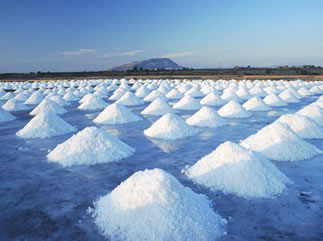The Roman saline

During the reign of Ancus Marcius part of the salary of the soldiers was given in salt from which the term wages derives.
Plinius the Old man was asserting that it is not possible to conceive a life civilised without the production and the use of the salt, in fact the salt necessity developed from the Neolithic with spreading of the agriculture. The permanent populations who were living on the vegetable fruits were needing salt because their diet was poor, but more important they had necessity of being able to keep a long time the perishable foods as the meat and the fish: the salting was the technique that the coastal populations of the Mediterranean Sea adopted.
In pre-protohistoric age limited quantities of salt were produced making boiling the seawater to obtaining the salts crystals, but quite soon it was arrived to a more intensive production with the great saltworks to solar evaporation.
In X century B. C. the Veientii had the control of the Campus Salinarum sited along the coast at the right of the mouth of the Tiber; the great wealth that was arriving from the commerce of the salt was one of the motives of the wars between Veientii and Romans who already in VII century B. C. conquered the site.
The salt was reaching Rome long the river but also with the Campania road – that derived his name from Campus Salinarum - carried on charriot that were arriving directly to the Foro. The saltworks were factories very similar to the modern saltworks, where slaves and freedmen were working – their graves have been discovered in 2008 in the Malnome necropolis – under the control of the conductores (a kind of guardin).
In the area of the airport of Fiumicino archaeological excavations are bringing back to the light the canalisations, the basins of evaporation and the productive infrastructures that were the heart of the campus salinarum Romanorum; in the excavations an epigraph has been also found again an epigraph of two cconductores of the campus salinarum of Ancient Ostia with a dedication to Neptune.
In the imperial age the principal saltworks were belonging to the emperor who wasrent them; the minor saltworks had private owners who could not sell to the public, but only to the contractor of the imperial saltworks. The Romans built roads dedicated to the commerce of the salt: between them one of the principal ones was the road Salaria that was connecting the saltworks of the Piceno (Castra Truentinum) to Rome; the long road of 138 miles was crossing the Apennines and, at the half of the ancient track, it is still visible – in location Masso dell'Orso- the mile stone that was indicating the milium LXVIII. The mile stone of cylindrical shape rests on a square base that indicates the total height of the cippus to metre. 2,30 and it brings back the incision
"IMP. CAESAR. DIVI..... F. – AUGUSTUS (COS. XI). TRIB (U. POTEST. VIII. EX. S. C.) LXVIIII.".
The Romans had a high consideration of all that was indispensable to the life, so also the salt as the water had a sacred value and was used in the offers vote to the gods. The salt for his purify virtue was used in the sacrifices, particularly before killing the victim from there was strewed the head with a mixture of salt, spelt and water said mola salsa. The mola salsa was prepared by the Vestali, it could have cooked also like a focaccia and after having offered it to the divinity was distributed in little pieces to the believers, which purification act.
by M.L. ©ALL RIGHTS RESERVED (Ed 1.0 - 01/04/2015)






